

Table of contents
- Characteristics
- Location
- Floor
- Best planting time
- planting guide
- transplant
- Do not transplant indiscriminately
- Care
- Pour
- Fertilize
- Cut
- hibernate
- multiply
- sowing
- cuttings
- division
- Diseases
- gray mold
- leaf spot disease
- Pests: nematodes
The shrub or tree peony grows like a bush with heights of 150 to 200 cm. But it can take several years before it grows into a stately bush. As a striking solitary plant, it attracts everyone's attention with its attractive flowers. They impress with all imaginable colors, can be one or more colors, simple or filled and exude a very pleasant scent.
Characteristics
- plant family: Peony family (Paeoniaceae)
- Botanical name: Paeonia suffruticosa
- German name: Shrub Peony, Tree Peony
- Growth: shrubby, woody, perennial
- growth height: 150-200cm
- Blossom: large, ruffled or ruffled petals, white, yellow, pink, red, orange
- heyday: April/May to June
- Leaves: green, pinnate, lobed leaf margin
- Toxicity: Slightly toxic to humans, highly toxic to pets
- Lime tolerance: lime tolerant
Location
Tree peonies thrive best in sunny locations, but they also tolerate light shade. However, the abundance of flowers decreases the darker the location. Shrub peonies find it difficult to assert themselves against strong root competition from other plants. Therefore, immediate proximity to such plants should be avoided or sufficient distance should be ensured. A tree peony takes up an area of about two square meters. The longer it stays in one place, the more luxuriantly and magnificently it blooms. Consequently, it is important to choose the location wisely.
Floor
Above all, the soil should be permeable and deep. Well suited are loamy, humus-rich and nutrient-rich garden soils that are good at retaining moisture, especially in dry seasons. However, they should not be waterlogged. Heavy soils can be made more permeable with sand or gravel. Or you can plant something higher so that excess water can drain off easily. If it is rather sandy, mix in some compost or clay. A mulch layer of dry leaves can also be helpful. planting
Best planting time
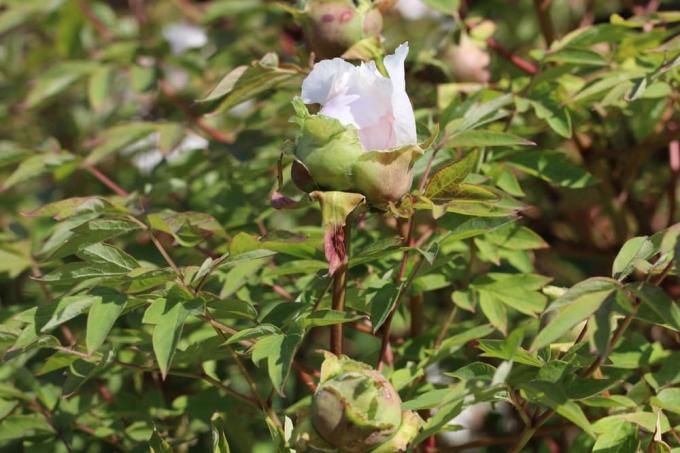
The correct planting time depends on the root packaging. Container specimens can be planted between March and November provided the soil is frost free. The months of August and September are ideal for bare-root peonies. The soil and fine roots were removed from bare-rooted plants. Planting should be completed by the end of September so that they can form fine roots again. Planting later can lead to growth regression and even total loss in very young specimens. They are fully established after three to five years. From then on, they are in full bloom.
planting guide
- Choose a cloudy day for planting
- First water the root ball thoroughly
- In the meantime, dig a sufficiently large planting hole
- At least twice as wide and deep as the pad
- Mix excavated earth with rotted humus
- Loosen the soil in the planting hole and fill in some soil
- Mix in some horn shavings to start with
- Insert peony at a slight angle
- Conducive to increased formation of main shoots and bushy growth
- Fill the planting pit with excavated earth
- Cover root base 3-4 cm with soil
- Set grafting point of grafted specimens deep enough
- Planting distances to other plants approx. 200cm
- After planting, cut back branches above ground except for a few eyes
- Thoroughly water the tree peony
Tip:
As a planting partner, you should give preference to species that underline the beauty of the tree peony and do not compete with it.
transplant
Shrub peonies want to be in the same place all the time. If it is necessary to transplant them, you should do this between August and September. In spring or early summer, the young shoots could break off very easily. In addition, the plants take root less well.
- Cut off roots widely
- Then carefully lift it out of the ground
- Prepare new planting site
- Plant tree peonies much deeper than garden peonies
- Place the grafting site 10-15 cm deep in the ground
- Be sure to plant scions too
- Finally rinse thoroughly
Most tree peonies are grafted on perennial peonies. In order for the scion of the tree peony to be able to detach itself from the substrate later, it must form its own roots.
Tip:
It can take up to two years for peonies to recover from transplant shock with little or no flowering.
Do not transplant indiscriminately
When transplanting, it is important not to plant where peonies were previously. A planting break of about ten years should be observed. The reason for this is the so-called soil fatigue, which leads to stunted growth and growth depression. Replacing the soil only makes sense if the whole thing is done extensively and, above all, deeply, because the roots of the shrub peony reach deep into the earth. The replacement is intended to prevent rotting root residues from the previous plant from remaining in the soil. They would harbor a high potential for disease.
Care
Under optimal conditions, tree peonies can reach an age of up to 60 years. Once established, they defy adversities such as summer drought. With increasing age, they lignify and are thus well protected from freezing temperatures. But otherwise they are undemanding and easy to care for, as long as you pay attention to a few basic things, especially when watering and fertilizing.
Pour
The water requirement of this attractive plant is rather low. Freshly planted specimens must be watered regularly for the first two years after planting. Later, watering is limited to longer dry periods. Since the roots get water from deeper soil layers, they don't dry out as quickly. In addition, the watering frequency depends on the water retention capacity or the storage capacity of the soil.
Fertilize

The need for nutrients is also comparatively low. You should fertilize from the second year at the earliest. Potash-phosphorus fertilization in late summer is recommended. It promotes the maturation of the wood and the formation of flowers. When choosing the fertilizer, make sure that it does not contain too much nitrogen. Otherwise, fertilizing twice a year is completely sufficient, the first time in spring just before budding and the second time immediately after flowering. It is advisable to fertilize organically, for example with well-rotted compost. The shrub peony is sensitive to fresh manure or artificial fertilizer.
Cut
- Cutting is usually not necessary, but sometimes useful
- Recommended for sprawling growth
- Slight pruning immediately after flowering
- Remove dead, disturbing and densely growing shoots
- Always cut above an unopened bud
- Cut off wilted flowers to prevent seed formation
- Rejuvenate older peonies if necessary
- To do this, shorten all shoots to 30-40 cm
Pruning before flowering is not recommended. Then it is very likely that you will have to remove the buds for the coming year and then have to do without flowering. A cut after mid-October is also unfavorable. The cuts can then no longer heal until the first frost. The result is frost damage.
hibernate
In the year of planting before the first winter it is advisable to cover the root area of the shrub peony with brushwood or dry leaves. Even if it is considered to be very hardy, the fresh shoots, which appear from around February, are endangered by late frost, as are the first buds in March. To protect the above-ground shoots from snow breakage, you can tie them together. If there is a threat of frost again in early spring, it makes sense to wrap the peony in fleece. As soon as no more frost is to be expected, the fleece must be removed again.
multiply
There are different ways to propagate the shrub peegonia, we show how to do it:
sowing
If you want to use seeds from existing plants, this is a bit tricky because they should still be slightly immature but not too immature. To be on the safe side, it is best to harvest on separate days.
- Stratify seeds immediately after harvest
- Necessary to break dormancy
- Place seeds in a plastic bag with damp sand
- Store in the refrigerator at four to five degrees for about two months
- During this period, formation of fine radicles
- Then put the whole thing in a warmer place, at around 20 degrees
- Continue to keep slightly moist
- Above-ground shoots with cotyledons can be seen in spring
- If not, repeat the process if necessary
- Seedlings then only in the second spring
Tip:
The flowers of the young plants obtained by sowing usually do not have the same properties as the mother plant.
cuttings
In late summer or autumn, cut off young, woody shoots that are 10-15 cm long. All but the top four or five leaves are removed, as are wilted flowers. Now put the cuttings about three centimeters deep in small pots with moist growing soil. In the coming weeks, the substrate must be kept evenly moist so that rooting can take place. Once roots have formed, do not plant the cuttings directly outside but leave them in the pots until a small ball has developed.
division
A division of tree peonies is only possible with grafted specimens, and then if the concerned Plant itself has arisen through division or it has already detached itself from the substrate and has its own roots trained.
- To dig out, loosen the earth again over a large area
- Expose bales as much as possible
- Carefully lift the plant out of the ground
- Do not pull out by the shoots
- Brittle roots could be damaged
- Remove loosely adhering soil as well as diseased and damaged root parts
- Divide the bales with a sharp knife or spade
Usually the bush falls apart by itself, so that you win several parts. They only have to be planted and watered at their destination.
Tip:
In order to create the necessary balance between root volume and shoot volume above ground, the latter is shortened by a little less than half.
Diseases
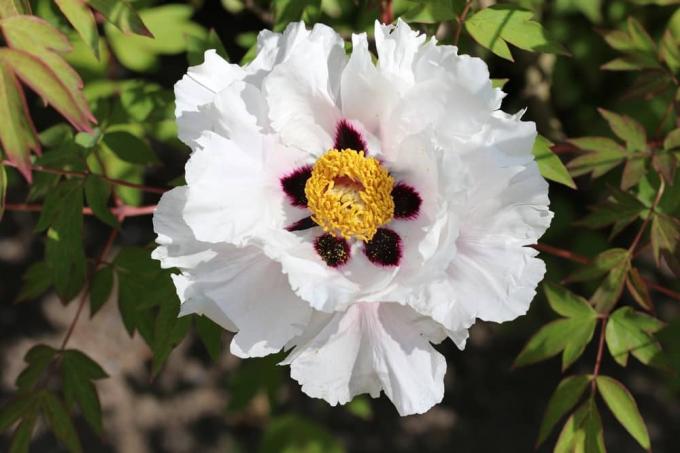
The shrub pegonia is susceptible to two main diseases. We show you how to recognize them and fight them successfully.
gray mold
The causative fungus finds optimal conditions on humus-rich soil and temperatures between 22 and 25 degrees. It causes brown, later rotting spots on leaves, flowers and stems. A mouse-grey, dusty coating forms. If there is an infestation, immediately cut out all affected parts down to the healthy tissue and dispose of them with household waste. If the infestation is already very advanced, the use of fungicides is often unavoidable.
leaf spot disease
Signs of this disease are large, conspicuous leaf spots that appear after spring has ended. They emanate from the edges and tips of the leaves, are light to violet-brown, enlarge and run into one another, the leaves dry up. In damp weather, the spots on the underside of the leaves are also covered with a velvety covering. To combat it, all affected parts of the plant must be removed and the clippings disposed of in the household waste. If that is not enough, fungicides may also have to be used.
Pests: nematodes
Nematode infestation is relatively rare. Stunted growth, leaf discoloration, significantly fewer flowers and bulbous growths on the roots can indicate this. Unfortunately, affected plants cannot usually be saved. They must be dug up and disposed of completely.
 garden editorial
garden editorial I write about everything that interests me in my garden.
Find out more about perennial lexicon

Lenten rose, Helleborus orientalis: 13 tips for care
The spring rose is one of the few plants that also blooms in winter. In order for the plant to bear its colorful flowers, however, certain requirements regarding location and care must be met.
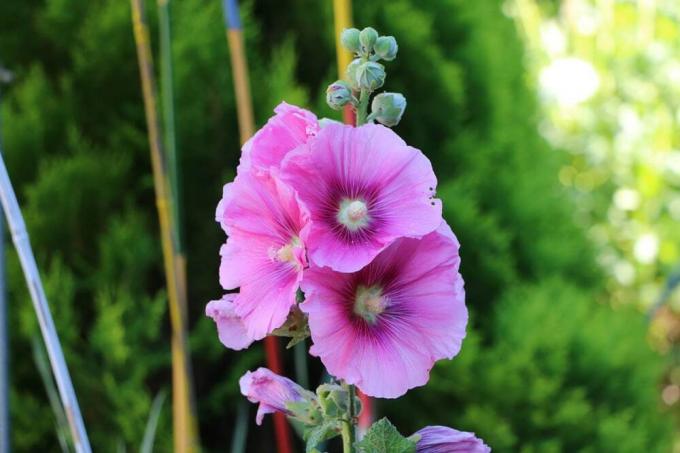
13 hardy perennials for sunny locations
Hardy perennials have a particularly long lifespan and allow sunny locations to bloom beautifully. At the beginning of each season, the perennial plants thrive anew and enchant the garden with a colorful world of flowers. Due to the large number of varieties, you have many design options.

Fat man: Care from A-Z | Planting distance and propagation
The shady areas under trees are neglected in many gardens, because only a few plants feel comfortable here. One of these few plants is the fat man (bot. Pachysander terminalis).
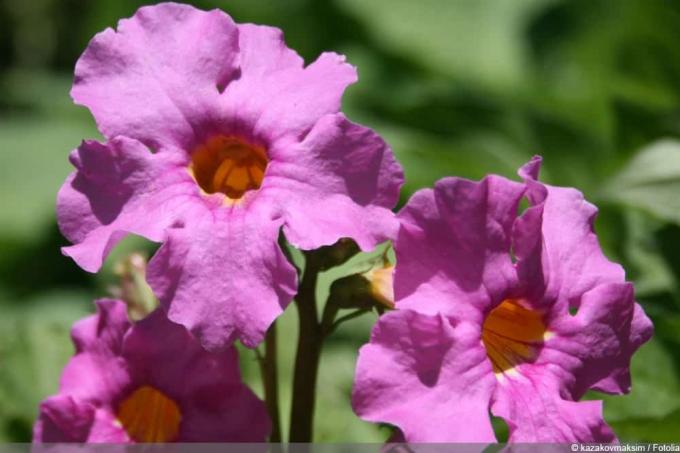
Flowering Fern: 14 Annual and Hardy Species | Care Instructions
A green fern with its beautifully designed fronds is a feast for the eyes in itself. It doesn't have to bloom to inspire. If flowers do appear, a garden gloxinia is actually at work. This flower is often incorrectly referred to as a blooming fern.
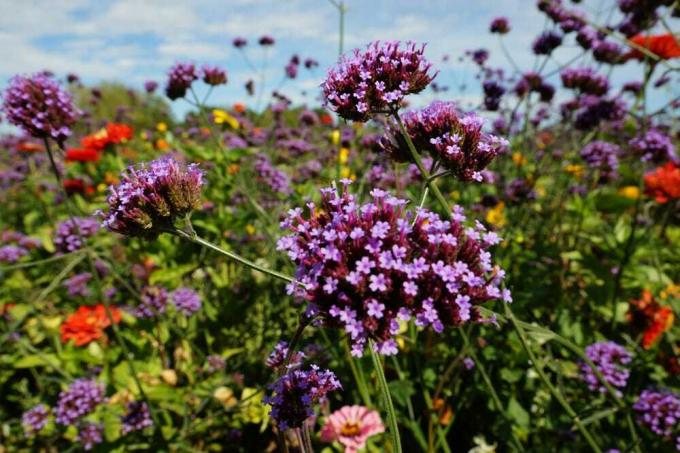
Patagonian Verbena, Verbena Bonariensis - Care Guide
Summer, sun, garden, flowers - here the Patagonian verbena is in its element, with fairy-like lightness purple flowers float on filigree stems above the flower bed and also attract all the butterflies area. Romantic gardeners love the effect of Verbena bonariensis, every gardener loves it Vigorous growth with the lowest maintenance requirements - verbena is a herb that benefits every garden brings.

Pot gerbera - instructions for caring for gerberas in pots
The pot gerbera is a lot of fun, but requires a lot of care. It needs to be watered daily and fertilized regularly. A lot of light is a must and yet it must not be exposed to excessive heat. But if you treat her properly, she will thank you with her beautiful flowers.
